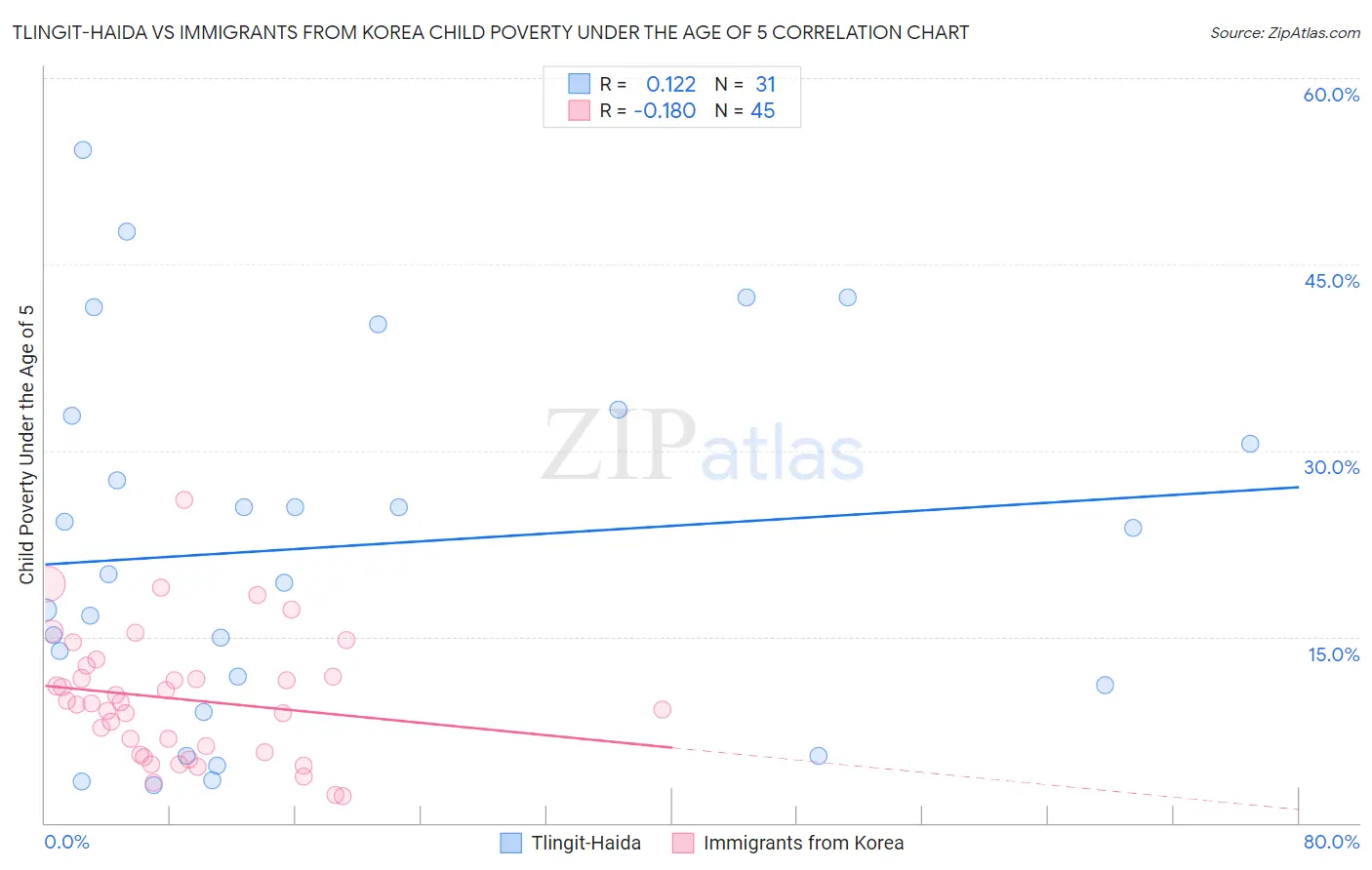Tlingit-Haida vs Immigrants from Korea Child Poverty Under the Age of 5
COMPARE
Tlingit-Haida
Immigrants from Korea
Child Poverty Under the Age of 5
Child Poverty Under the Age of 5 Comparison
Tlingit-Haida
Immigrants from Korea
15.9%
CHILD POVERTY UNDER THE AGE OF 5
94.7/ 100
METRIC RATING
106th/ 347
METRIC RANK
13.2%
CHILD POVERTY UNDER THE AGE OF 5
100.0/ 100
METRIC RATING
11th/ 347
METRIC RANK
Tlingit-Haida vs Immigrants from Korea Child Poverty Under the Age of 5 Correlation Chart
The statistical analysis conducted on geographies consisting of 59,941,006 people shows a poor positive correlation between the proportion of Tlingit-Haida and poverty level among children under the age of 5 in the United States with a correlation coefficient (R) of 0.122 and weighted average of 15.9%. Similarly, the statistical analysis conducted on geographies consisting of 396,775,886 people shows a poor negative correlation between the proportion of Immigrants from Korea and poverty level among children under the age of 5 in the United States with a correlation coefficient (R) of -0.180 and weighted average of 13.2%, a difference of 20.4%.

Child Poverty Under the Age of 5 Correlation Summary
| Measurement | Tlingit-Haida | Immigrants from Korea |
| Minimum | 3.0% | 2.2% |
| Maximum | 54.2% | 26.0% |
| Range | 51.2% | 23.8% |
| Mean | 22.3% | 10.0% |
| Median | 20.0% | 9.6% |
| Interquartile 25% (IQ1) | 11.1% | 5.6% |
| Interquartile 75% (IQ3) | 32.8% | 12.3% |
| Interquartile Range (IQR) | 21.7% | 6.7% |
| Standard Deviation (Sample) | 14.3% | 5.1% |
| Standard Deviation (Population) | 14.1% | 5.0% |
Similar Demographics by Child Poverty Under the Age of 5
Demographics Similar to Tlingit-Haida by Child Poverty Under the Age of 5
In terms of child poverty under the age of 5, the demographic groups most similar to Tlingit-Haida are Immigrants from Spain (15.9%, a difference of 0.050%), Immigrants from North America (15.9%, a difference of 0.12%), Slovene (16.0%, a difference of 0.14%), Immigrants from Brazil (16.0%, a difference of 0.16%), and Northern European (16.0%, a difference of 0.24%).
| Demographics | Rating | Rank | Child Poverty Under the Age of 5 |
| Palestinians | 95.9 /100 | #99 | Exceptional 15.8% |
| Immigrants | Canada | 95.9 /100 | #100 | Exceptional 15.8% |
| Immigrants | Zimbabwe | 95.9 /100 | #101 | Exceptional 15.8% |
| Armenians | 95.7 /100 | #102 | Exceptional 15.8% |
| Europeans | 95.3 /100 | #103 | Exceptional 15.9% |
| Immigrants | North America | 94.9 /100 | #104 | Exceptional 15.9% |
| Immigrants | Spain | 94.8 /100 | #105 | Exceptional 15.9% |
| Tlingit-Haida | 94.7 /100 | #106 | Exceptional 15.9% |
| Slovenes | 94.4 /100 | #107 | Exceptional 16.0% |
| Immigrants | Brazil | 94.4 /100 | #108 | Exceptional 16.0% |
| Northern Europeans | 94.3 /100 | #109 | Exceptional 16.0% |
| Romanians | 94.3 /100 | #110 | Exceptional 16.0% |
| Pakistanis | 94.2 /100 | #111 | Exceptional 16.0% |
| Peruvians | 94.1 /100 | #112 | Exceptional 16.0% |
| Puget Sound Salish | 94.1 /100 | #113 | Exceptional 16.0% |
Demographics Similar to Immigrants from Korea by Child Poverty Under the Age of 5
In terms of child poverty under the age of 5, the demographic groups most similar to Immigrants from Korea are Immigrants from South Central Asia (13.3%, a difference of 0.10%), Burmese (13.2%, a difference of 0.11%), Bhutanese (13.4%, a difference of 0.86%), Immigrants from Iran (13.1%, a difference of 1.2%), and Iranian (13.1%, a difference of 1.4%).
| Demographics | Rating | Rank | Child Poverty Under the Age of 5 |
| Thais | 100.0 /100 | #4 | Exceptional 12.3% |
| Immigrants | Hong Kong | 100.0 /100 | #5 | Exceptional 12.4% |
| Immigrants | Singapore | 100.0 /100 | #6 | Exceptional 12.9% |
| Chinese | 100.0 /100 | #7 | Exceptional 13.1% |
| Iranians | 100.0 /100 | #8 | Exceptional 13.1% |
| Immigrants | Iran | 100.0 /100 | #9 | Exceptional 13.1% |
| Burmese | 100.0 /100 | #10 | Exceptional 13.2% |
| Immigrants | Korea | 100.0 /100 | #11 | Exceptional 13.2% |
| Immigrants | South Central Asia | 100.0 /100 | #12 | Exceptional 13.3% |
| Bhutanese | 100.0 /100 | #13 | Exceptional 13.4% |
| Okinawans | 100.0 /100 | #14 | Exceptional 13.4% |
| Indians (Asian) | 100.0 /100 | #15 | Exceptional 13.4% |
| Immigrants | Eastern Asia | 100.0 /100 | #16 | Exceptional 13.5% |
| Assyrians/Chaldeans/Syriacs | 100.0 /100 | #17 | Exceptional 13.6% |
| Immigrants | China | 100.0 /100 | #18 | Exceptional 13.6% |